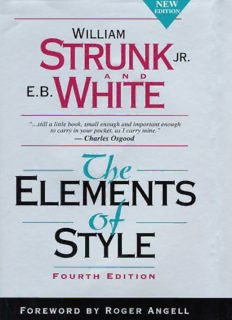
The Elements of Style, 4e PDF
Preview The Elements of Style, 4e
The Elements of Style T HE ELEMENTS OF Style BY WILLIAM STRUNK Jr. With Revisions, an Introduction, and a Chapter on Writing BY E.B.WHITE F O U R TH E D I T I ON New York San Francisco Boston London Toronto Sydney Tokyo Singapore Madrid Mexico City Munich Paris Cape Town Hong Kong Montreal COPYRIGHT © 2000,1979, ALLYN & BACON A Pearson Education Company Needham Heights, Massachusetts 02494 All rights reserved. No part of this book may be reproduced or transmitted in any form or by any means, electronic or mechanical, including photo- copying, recording, or any information storage and retrieval system, without permission in writing from the Publisher. Earlier editions © 1959, 1972 by Macmillan Publishing Co., Inc. The Introduction originally appeared, in slightly different form, in The New Yorker, and was copyrighted in 1957 by The New Yorker Magazine, Inc. The Elements of Style, Revised Edition, by William Strunk Jr. and Edward A. Tenney, copyright 1935 by Oliver Strunk. Library of Congress Cataloging-in-Publication Data Strunk, William, 1869-1946. The elements of style / by William Strunk, Jr. ; with revisions, an introduction, and a chapter on writing by E. B. White. — 4th ed. p. cm. Includes index. ISBN 0-205-30902-X (paperback). — ISBN 0-205-31342-6 (casebound) 1. English language—Rhetoric. 2. English language—Style. 3. Report writing. I. White, E. B. (Elwyn Brooks), 1899- . II. Title. PE1408.S772 1999 808'.042—dc21 99-16419 CIP PRINTED IN THE UNITED STATES OF AMERICA 10 9 8 7 04 03 02 Contents FOREWORD ix INTRODUCTION xiii I. ELEMENTARY RULES OF USAGE 1 1. Form the possessive singular of nouns by adding s. 1 2. In a series of three or more terms with a single conjunction, use a comma after each term except the last. 2 3. Enclose parenthetic expressions between commas. 2 4. Place a comma before a conjunction introducing an independent clause. 5 5. Do not join independent clauses with a comma. 5 6. Do not break sentences in two. 7 7. Use a colon after an independent clause to introduce a list of particulars, an appositive, an amplification, or an illustrative quotation. 7 8. Use a dash to set off an abrupt break or interruption and to announce a long appositive or summary. 9 9. The number of the subject determines the number of the verb. 9 10. Use the proper case of pronoun. 11 vij CONTENTS 11. A participial phrase at the beginning of a sentence must refer to the gram- matical subject. 13 II. ELEMENTARY PRINCIPLES OF COMPOSITION 15 12. Choose a suitable design and hold to it. 15 13. Make the paragraph the unit of com- position. 15 14. Use the active voice. 18 15. Put statements in positive form. 19 16. Use definite, specific, concrete language. 21 17. Omit needless words. 23 18. Avoid a succession of loose sentences. 25 19. Express coordinate ideas in similar form. 26 20. Keep related words together. 28 21. In summaries, keep to one tense. 31 22. Place the emphatic words of a sentence at the end. 32 III. A FEW MATTERS OF FORM 34 IV. WORDS AND EXPRESSIONS COMMONLY MISUSED 39 V. AN APPROACH TO STYLE (With a List of Reminders) 66 1. Place yourself in the background. 70 2. Write in a way that comes naturally. 70 3. Work from a suitable design. 70 4. Write with nouns and verbs. 71 5. Revise and rewrite. 72 6. Do not overwrite. 72 7. Do not overstate. 73 8. Avoid the use of qualifiers. 73 9. Do not affect a breezy manner. 73 10. Use orthodox spelling. 74
